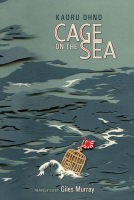 Author: Kaoru Ohno
Author: Kaoru Ohno
Translator: Giles Murray
U.S. publisher: Bento Books
ISBN: 9780983951384
Released: March 2014
Original release: 1998
Cage on the Sea is the first book by Kaoru Ohno to be translated and released in English. The novel, originally published in Japan in 1998, was released in English by Bento Books in 2014 with a translation by Giles Murray. It was Bento Books’ involvement that brought Cage on the Sea to my attention. Though he has written novels, Ohno is primarily known as a journalist and as an author of nonfiction works with a particular emphasis on Japanese military history and World War II. Cage on the Sea suits Ohno’s interests perfectly. Based on a true story and meticulously researched, Cage on the Sea is about a group of Japanese holdouts on Anatahan, a remote island in the Marianas, and their eventual repatriation after World War II. Their tale of survival was sensationalized by the mass media in the 1950s and has served as an inspiration for various other films and novels in addition to Ohno’s Cage on the Sea. Though once a well-known story, more than fifty years later relatively few people are as familiar with this particular history of Anatahan.
In 1944 three Japanese ships—the Hyosukemaru, Akebonomaru, and Kaihomaru—were destroyed by American air raids on the Mariana Islands, stranding the surviving crew on the sparsely populated island of Anatahan. They expected reinforcements and rescue to follow soon afterwards, but days, weeks, months, and eventually years passed before they would leave the island. Initially sheltered by employees of the South Sea Development Company supervising copra production on Anatahan, the more than thirty men quickly exhausted the food stores and supplies meant for less than a handful of people. With resupply increasingly unlikely and with the continued bombardment by the Americans, the group fled for the island’s forested interior, doing their best to survive off of the land by foraging and growing what they could and by capturing lizards and bats for food. After the war in 1950, James B. Johnson, a United States naval commander, began attempts to peacefully remove the Japanese holdouts from the island, hoping to prevent additional casualties on both sides. But by that point, due to injury, disease, and infighting, only twenty men and a single woman, Kazuko Higa, were still alive.
Despite the multitude of named characters (all of whom are based on actual people), Cage on the Sea primarily follows the perspectives of three men: Lieutenant Commander Johnson, Sugataro Nakai, a seaman aboard the Hyosukemaru and a balladeer, and Seargent Junzo Itami of the Kaihomaru, the highest ranking member of the Japanese military present on Anatahan. But the person with the most vital role in Cage of the Sea, the focus to the point of obsession for many of the men and the reason for so much of the group’s conflict and strife, is Kazuko Higa. Johnson’s account actually provides the framing story for the novel, looking back on the events surrounding the repatriation of the Anatahan holdouts from the perspective of his retirement. In particular, he wonders what has become of Higa. Nakai and Itami’s narratives deal more specifically with the efforts to survive on a nearly uninhabited island for seven years, capturing the constantly shifting social dynamics and alliances among the group—a mix of civilians, seamen and fishermen, and enlisted men.
Frequently, Cage on the Sea almost feels as though it’s a documentary. Ohno has put a tremendous amount of research into the work, motivated by the question of what it must have been like to have lived and survived from one day to the next on Anatahan Island for all of those years. He read the memoirs of Michiro Maruyama, one of the survivors; he spoke with and interviewed the holdouts and those who knew them; perhaps most importantly, he gained access to Johnson’s personal archives and to the materials recording the efforts to peacefully rescue the Japanese from Anatahan. Prior to the Anatahan mission, holdouts who resisted surrender were met with force. Johnson’s innovative approach unquestionably saved lives. In the end, Cage on the Sea is a novel, so to some extent the events and key players have been fictionalized and dramatized—but Ohno treats the story with realism, sympathy, and respect, avoiding sensationalism and presenting a much more nuanced version of the events and the people involved than had previously been seen.

This sounds interesting! I’ll definitely look for this book and find out more about this publisher. Thanks!
My pleasure! I hope you enjoy if you get a chance to read it. Bento Books has some really interesting looking releases coming up in the next couple of years, and some of my favorite translators are associated with the publisher, too. :)